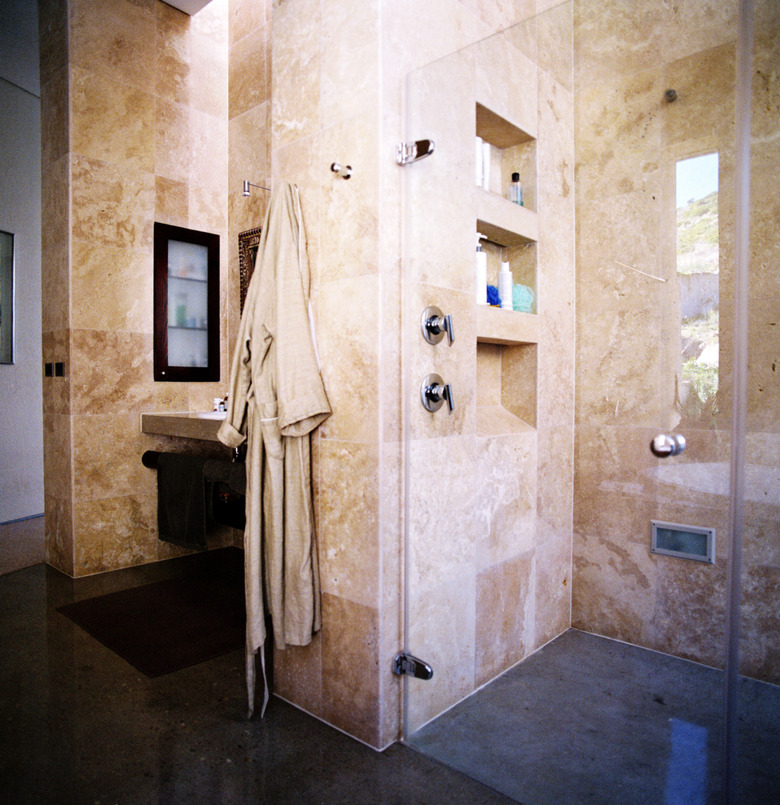How To Build A Mud Pan Shower
Prefabricated shower pans are commonplace, but a traditional mud pan shower is worth the effort required to build it. Another benefit is that you can build the shower any dimensions that you like; you're not restricted by standard shower pan sizes. Mud means many different things in the construction world.
Prefabricated shower pans are commonplace, but a traditional mud pan shower is worth the effort required to build it. Another benefit is that you can build the shower any dimensions that you like; you're not restricted by standard shower pan sizes. Mud means many different things in the construction world. When it comes to shower pans, it's simply Portland cement, sand and water.
Subfloor
The best mud pan won't last if the subfloor can't support it. Factoring in the pan, concrete board on the walls, mortar, tile and grout, a traditional mud-base shower can easily weigh 1,000 pounds. If the home is on a concrete slab, it's safe to assume that the floor will support the shower. With a plywood subfloor, some inspection is in order. Previous water damage from another shower or tub is revealed as dark spots and warped areas. Hiring a contractor to strengthen or rebuild a soft subfloor adds years to the life of the shower.
- Prefabricated shower pans are commonplace, but a traditional mud pan shower is worth the effort required to build it.
- If the home is on a concrete slab, it's safe to assume that the floor will support the shower.
Framing the Curb
The shower curb, which is the raised lip across the opening, is built by stacking three or more two-by-fours and fastening them to the floor. This keeps water from running out across the bathroom floor. Although you can build a rectangular box from the lumber and fasten it, stacking the boards makes the curb as dense as possible. If the subfloor is concrete, you need a concrete curb instead of wood. Spread mortar on the concrete and set a row of solid concrete blocks in the mortar as if you're laying bricks. A concrete curb should cure for a few days before proceeding.
Pre-Slope
The slope toward the drain begins before installing the waterproof shower membrane. A flat membrane doesn't direct water toward the drain. With a wood subfloor, the pre-slope is a multistep process. Tar paper is stapled to the floor, and fine wire mesh, called metal lath, is stapled over the tar paper. A layer of stiff mud is then packed over the lath. The mud mix should hold its shape when you squeeze a handful. The right slope is approximately 1 1/2-inches-thick at the edges of the shower and gradually decreases to 3/4-inch-thick at the drain. A trowel or board smooths the mud. A spreadable, not stiff, mud mix with the same thicknesses and slope are what you need on a concrete subfloor.
- The shower curb, which is the raised lip across the opening, is built by stacking three or more two-by-fours and fastening them to the floor.
- A spreadable, not stiff, mud mix with the same thicknesses and slope are what you need on a concrete subfloor.
Waterproof Membrane
Mud pan shower liners are a heavy, flexible sheet material made from polyvinyl chloride, or PVC. Cut the drain opening in the liner smaller than the perimeter of the drain to avoid leaks. The membrane is smoothed across the pre-sloped shower floor and up the walls at least 12 inches, folding the corners to fit instead of cutting them. The membrane wraps around the curb as well, but you'll need to trim off the excess and waterproof it with membrane adhesive. No nails or staples are used to fasten the membrane except around the uppermost edge on the wall and along the bottom edge outside the curb. After the membrane is installed, lath is installed around the curb and stapled or nailed to the outside. If the curb is concrete, no lath is necessary.
- Mud pan shower liners are a heavy, flexible sheet material made from polyvinyl chloride, or PVC.
- The membrane is smoothed across the pre-sloped shower floor and up the walls at least 12 inches, folding the corners to fit instead of cutting them.
Top Mud Layer
The top layer of mud is a stiff mix consisting of approximately 5 parts sand, 1 part Portland cement and only enough water to make the materials clump and stick together. Mix the dry ingredients before adding water. Mud can clog the drain line, so cover the drain openings with tape until the pan is finished. Pack the mud approximately 1 1/2 inches thick from the walls to the drain, keeping the same slope as the underlying layer, and smooth it with the trowel or board. To finish the curb, pack stiff mortar over the lath or spread a thinner mix over concrete blocks. You can install backer board on the walls after the pan is set, which can take 24 to 48 hours.
